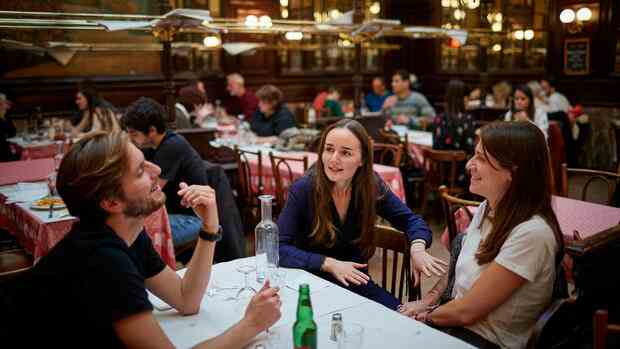From 7 p.m., long queues form in front of the Bouillon République, even on weekdays. Young and old alike wait patiently to be admitted to the restaurant on the Place de la République. It’s impossible to book because the 1,800-square-foot eatery — dated, with lots of wood, brass, and Art Nouveau decor — is so hip.
Almost forgotten until recently, bouillons, the people’s dining halls, are enjoying an amazing renaissance in Paris and now other cities in France.
Currently, new restaurants open every month. Inflation brings them more crowds, because even in times of rising prices, the French don’t want to do without their favorite pastime: eating.
In times of crisis, “comfort food” is back in fashion, just like it was in grandma’s time. The traditional dishes are replacing the eating trends of the past few years, which were primarily characterized by international influences or fast food. The “Bouillons” are noisy and huge bistros, the waiters serve in a hurry and are usually not particularly friendly or patient – but that’s just part of the Parisian flair.
The terminology of the new “bouillons” is misleading: not only broths (bouillon) are served here, the restaurants have nothing in common with fashionable soup restaurants: it’s all about French home cooking. Classics such as steak fries, sausage with mashed potatoes, leeks with vinegar sauce, chicken with chips and beef stew are served.
>> Read also: Record core inflation – Price pressure in the euro area is affecting more and more areas of the economy
The public is mixed, many young people come who pay attention to the prices. The restaurants appear very nostalgic, with lots of wood, mirrors, stucco, old bistro chairs and posters with Paris motifs. The new generation of restaurateurs often settles in old restaurants that are no longer running.
In contrast to many other establishments, the Bouillons usually offer warm food all day long. This is the case in the “Bouillon Chartier Montparnasse” or in the “Bouillon Chartier Gare de l’Est”. These are the two branches of the famous “Chartier”, located near the large department stores Printemps and Galeries Lafayette. “The idea is to offer a starter, a main course and a dessert for less than 20 euros,” explains Christophe Joulie, one of the owners of Bouillon Chartier. That’s about half of what customers usually pay in Parisian restaurants.
The Chartier Bouillon restaurant near the Grands Boulevards is the historic model of the new dining scene.
(Photo: Getty Images)
Established in 1896, Chartier is the only restaurant of its kind that has survived to this day. At the beginning of the 20th century there were still over 200 of these bars, whose economic success was based on mass processing. They were created around 1860 in the Hallenviertel district of Paris and served workers as a canteen. At that time, soup was the main food.
By the end of the 20th century all but the Chartier had disappeared, converted into expensive restaurants. But now her concept is more relevant than ever. Starting in Paris, the trend spread like a wave – today Lille, Grenoble, Lyon, Orléans and other provincial cities also have bouillons.
The restaurateurs stock up on the largest Parisian wholesale market – they buy what is currently on offer cheaply.
(Photo: Rungis)
Most emerged after the pandemic lockdowns, when rising prices and purchasing power left more and more French people financially overwhelmed. Even Versailles has had the “Petit Bouillon Versailles” since January. “It’s going really well in times of a difficult economy,” says its boss Didier Lacoste, who serves 500 meals a day. A meal with him, including drinks and a view of the castle, costs 22 euros.
>> Read also: Top restaurateur Tim Mälzer on inflation: “I deliberately forgo margin”
The Bouillons economic model works by crowd, they often have more than 300 seats, serve up to 3000 meals a day and are open 24 hours a day. The value for money is unbeatable. The chefs buy their ingredients in large quantities at the Rungis wholesale market outside of Paris and tailor their menus to what they can get particularly cheaply.
France’s capital has become almost unaffordable for middle-income people in recent decades, and inflation is compounding this trend. Now a new generation of restaurateurs is at least making restaurant visits affordable again.
(Photo: Luigi Vaccarella/Schapovalov)
There are no huge restaurant chains behind the bouillons, but rather family businesses that have been active in the gastronomy sector for a long time and have already set other trends. Christophe Joulie, who comes from a family of restaurant owners from Auvergne in central France, bought Chartier 15 years ago. Back then, nobody believed in the concept anymore, and only a few hundred customers came a day. Today he is considered a trendsetter.
Joulie is surprised by the success herself. He serves up to 2,400 customers a day and has set himself the goal of one million meals a year by 2023. He also owns the Montparnasse and Gare de l’Est branches, which he opened in 2019 and 2022.
His main competitor is Pierre Moussié, who has also been active in the restaurant and hotel sector for a long time. He only opened “Bouillon Pigalle” in 2017 and then a branch in the République at the end of 2021. Both underbid each other with the prices. Vegetable soups are available from one euro, eggs and mayonnaise from two euros. If you go out to eat in the afternoon and not at lunchtime or in the evening, you don’t even have to stand in line.
More: Seven boss strategies to master the current crisis
